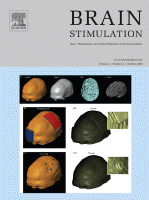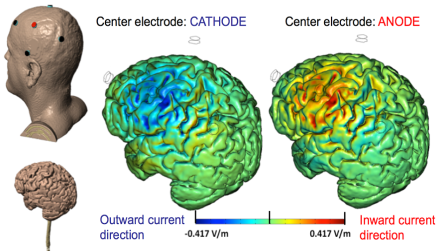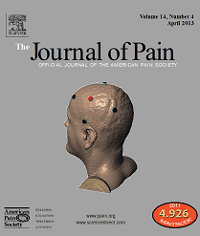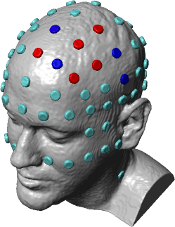What is HD-tDCS?
High-Definition transcranial Direct Current Stimulation (HD-tDCS) is a transformative technology for targeting cortical and deep brain structures with weak DC currents. Unlike any other neuromodulation technique, HD-tDCS is non-invasive, targeted, and can leverage the therapeutic potential, convenience, safety, and cost-advantages of tDCS. Soterix medical is the exclusive manufacturer and provider of HD-tDCS technology.

HD-tDCS Overview
Soterix Medical High-Definition transcranial Direct Current Stimulation (HD-tDCS) is a non-invasive technique where brain regions are targeted using arrays of electrodes on the scalp. In contrast to conventional tDCS, which uses large sponge electrodes, HD-tDCS uses our exclusive Soterix Medical “High-Definition” small gel based electrodes. This proprietary technology is the only hardware that allows safe and tolerated passage of current through small electrodes on the scalp, as validated in clinical trials. HD-tDCS provides users with tremendous flexibility in determining brain targets through the use of Soterix Medical Neurotargeting Software. Fully integrated with every HD-tDCS hardware system, Neurotargeting makes optimized and individualized therapy as easy as a push of a button.

Soterix Medical HD-tDCS Highlights
- The only hardware validated for safe and tolerated stimulation in multi-center clinical trials. Other technologies and devices marketed for “small electrode transcranial stimulation” are not endorsed by Soterix Medical and are counter-indicated for use with any Soterix Medical stimulator or software, including 4×1 HD-tDCS. Soterix Medical is committed to the advancement of rational non-invasive neuromodulation through application of the highest scientific and medical standards.
- Exclusive Neurotargeting Software for dose optimization. Given the flexibility of HD-tDCS, with independently controlled electrodes deployed anywhere on the head, software that allows simple and optimized set-up is critical. Soterix Medical developed Neurotargeting Software exactly for this purpose including a range of exclusive features all designed to make dose optimization for your clinical trial simple and convenient.
- Conduct clinical studies with state-of-the-art control and safety features. Soterix Medical developed HD-tDCS and clinicians trust our team of scientists and biomedical engineers to ensure every HD-tDCS devices is designed and manufactured based on the most state-of-the-art evidence and techniques. Soterix Medical is the industry standard for non-invasive brain stimulation and nowhere is this more important than in HD-tDCS.
- Provide for simple and comfortable set-up and stimulation. Usability and simplicity underpin every Soterix Medical device and HD-tDCS is no exception. We recognize that state-of-the-art neuromodulation tools are only as effective as they can be understood and controlled by operators. Our human factors engineers review every aspect of HD-tDCS stimulator and accessories to ensure that advanced neuromodulation does not come at the cost of complexity in use. Our unparalleled customer support ensures you have all the guidance and support, when you need it.
Four things about HD-tDCS
- 4×1 HD-tDCS. High-Definition transcranial Direct Current Stimulation (HD-tDCS) was invented at The City University of New York with the introduction of the 4×1 HD-tDCS montage (Datta 2009). The 4×1 HD-tDCS montage categorically transformed the possibilities with non-invasive neuromodulation by allowing precise targeting of cortical structures. How focal is 4×1 HD-tDCS? The region of current flow is circumscribed by the area of the 4x ring, such that decreasing ring radius increases focality. Soterix Medical Neurotargeting software makes HD montage design fast and easy, but the innovation did not stop there. Scientists went on to demonstrate that 4×1 HD-tDCS allows for unifocal stimulation, meaning the polarity of the center 1x electrode will determine the direction of neuromodulation under the ring (Villamar 2013). This is in contrast to conventional tDCS where the need for one anode and one cathode always produces bidirectional modulation (even when an extra-cephalic electrode is used). 4×1 HD-tDCS thus provides the ability not only to select a cortical brain region to target, but to modulate the excitability of that brain region with a designed polarity without having to consider return counter-electrode flow.

- High-Definition Electrodes. There is only one electrode design that has been engineered for HD-tDCS, validated in extensive clinical testing, and used in clinical trials. The High Definition electrode was designed at The City University Of New York (Minhas 2010) and been proven safe and well tolerated in multi-center clinical trials (Borckardt 2012, Villamar 2013, Kuo 2013). It is critical investigators do not attempt multi-electrode stimulation with non-validated “off-brand” devices under the assumption these approaches have any relevance to Soterix Medical HD-tDCS technology or clinically validated approaches. Use of off-brand electrodes and devices compromise research integrity, patient safety, and interferes with the rational development of HD-tDCS by the research community.

- Peak Neuromodulation. A critical question given the targeting of 4×1 HD-tDCS is “when is focality desired?” There is no simple answer to this question but is it important to recognize that most conventional tDCS approaches produce current flow through >50% of the brain including deep brain structures and that with conventional tDCS inter-individual anatomical difference means the location of peak brain electric field will vary widely. Therefore, by guaranteeing peak brain electric field at the target and restricting brain current flow to a limited region, 4×1 HD-tDCS confers some theoretical clinical benefits. In ongoing clinical trials, 4×1 HD-tDCS has consistently produced effects size comparable or exceeding alternative neuromodulation protocols, including in control of experiment and clinical pain (Borckardt 2012, Villamar 2013). More striking, in a direct comparison with conventional tDCS, Nitsche and Paulus demonstrated that 4×1 HD-tDCS produces change in brain excitability that significantly exceeds both the magnitude and duration of conventional tDCS (Kuo 2013).

- Arbitrary HD electrode placement. Number and precision. In advanced neuromodulation design, software and hardware that allow arbitrary placement of HD electrodes on the head is required. Precision of montage matters critically, which is why stimulation software and supporting hardware must provide user with flexibility and precision in control. Don’t be confused by copycat hardware and software that provides neither flexibility nor precision. State-of-the-art neurotargeting software and hardware, with flexibility and precision, exclusively from the industry leader in non-invasive electrical stimulation, brought to you by Soterix Medical.

Learn more about Soterix Medical 4×1 Active HD-tDCS device, please click https://soterixmedical.com/research/hd-tdcs#4x1active or reach us at contact@amperemedical.com.hk.
